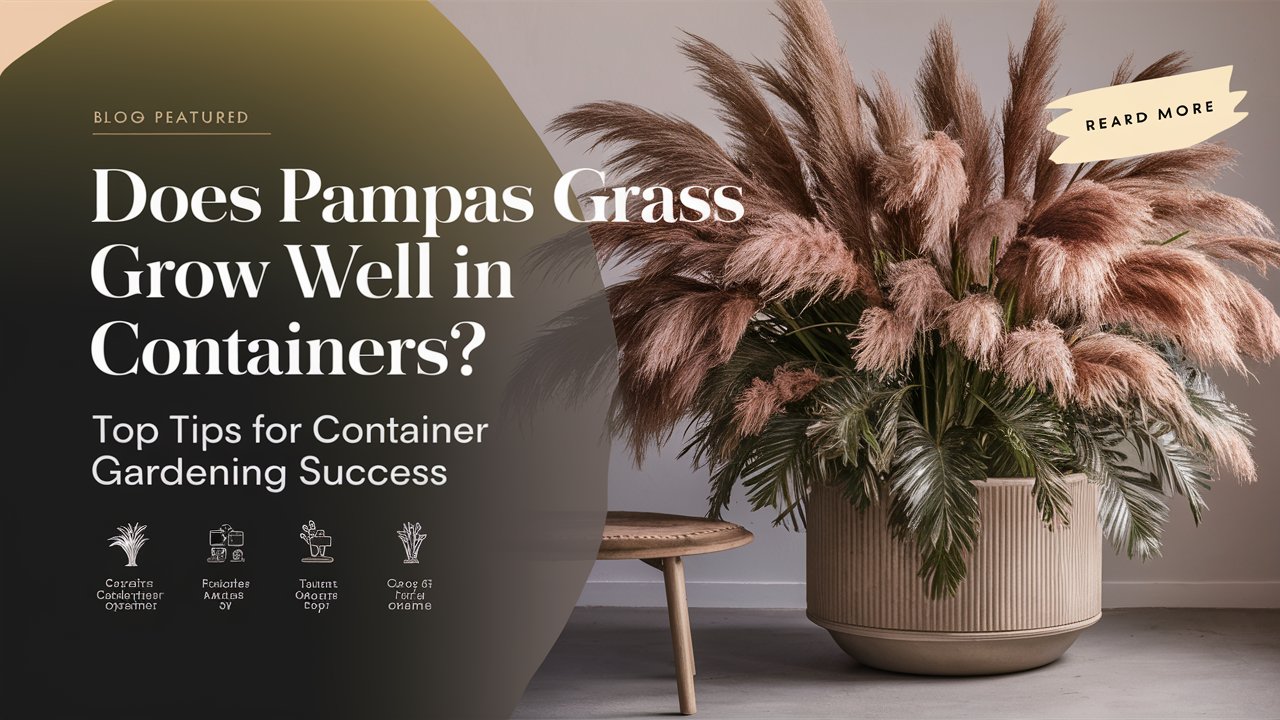Introduction
Does pampas grass grow well in containers? This is a common question for garden enthusiasts who are captivated by the elegant, feathery plumes of pampas grass but have limited garden space. The good news is that pampas grass can indeed thrive in containers, offering a stunning visual appeal to patios, balconies, and other small outdoor spaces. In this blog post, we’ll explore the best practices for growing pampas grass in containers, ensuring your plants stay healthy and vibrant.
Why Choose Pampas Grass for Containers?
Pampas grass (Cortaderia selloana) is renowned for its tall, plume-like flowers and lush green foliage. Growing pampas grass in containers allows you to enjoy its beauty even in limited spaces. This approach also offers better control over soil conditions, drainage, and mobility of the plant.
Selecting the Right Container
Size Matters
Choosing the right container is crucial for the health of your pampas grass. The container should be large enough to accommodate the root system, ideally at least 18-24 inches in diameter and depth. This size ensures that the roots have enough space to grow and access nutrients.
Material Considerations
Containers can be made from various materials such as plastic, ceramic, or metal. Each material has its pros and cons:
- Plastic: Lightweight and easy to move, but may not provide adequate insulation for roots.
- Ceramic: Attractive and provides good insulation, but can be heavy and prone to cracking.
- Metal: Durable and stylish, but may heat up too much in direct sunlight, potentially harming the roots.
Ensure your chosen container has drainage holes to prevent waterlogging, which can lead to root rot.
Soil and Planting Requirements
Ideal Soil Mix
Pampas grass prefers well-draining soil. A mix of potting soil, sand, and perlite or pumice works well. This combination ensures good drainage while retaining enough moisture for the plant.
Planting Process
- Fill the container with the soil mix, leaving a few inches from the top.
- Create a hole in the center and place the pampas grass root ball into the hole.
- Fill around the root ball with soil, pressing down gently to eliminate air pockets.
- Water thoroughly to settle the soil around the roots.
Watering and Fertilizing
Watering Tips
Pampas grass is drought-tolerant once established, but regular watering is crucial during the initial growth phase. Water the plant thoroughly when the top inch of soil feels dry. Avoid overwatering, as this can lead to root rot.
Fertilization
Feed your pampas grass with a balanced, slow-release fertilizer in the spring. This provides essential nutrients for growth. Reapply fertilizer every 6-8 weeks during the growing season for optimal results.
Pruning and Maintenance
Pruning
Pruning pampas grass helps maintain its shape and promotes new growth. Cut back the foliage to about 6 inches above the soil level in late winter or early spring. This removes dead or damaged leaves and makes way for fresh growth.
Maintenance
Regularly check for pests such as aphids or spider mites. Treat infestations promptly with insecticidal soap or neem oil. Also, remove any dead or diseased foliage to keep the plant healthy.
Common Issues and Solutions
Root Bound Plants
If your pampas grass becomes root bound, it may show signs of stunted growth or wilting. To resolve this, repot the plant into a larger container or divide the root ball and replant the sections.
Yellowing Leaves
Yellowing leaves can indicate overwatering or poor drainage. Ensure your container has adequate drainage and adjust your watering schedule accordingly.
Benefits of Growing Pampas Grass in Containers
Growing pampas grass in containers offers several advantages:
- Mobility: Easily move the containers to different locations for optimal sunlight or protection from harsh weather.
- Control: Better control over soil quality, drainage, and watering.
- Aesthetic Appeal: Enhance the beauty of patios, balconies, or entryways with the striking plumes of pampas grass.
Conclusion
So, does pampas grass grow well in containers? Absolutely! With the right container, soil mix, and care, you can enjoy the lush beauty of pampas grass even in small spaces. Follow these tips to ensure your pampas grass thrives and adds a touch of elegance to your outdoor area.
FAQs
What size container is best for growing pampas grass?
Pampas grass thrives best in containers that are at least 18-24 inches in diameter and depth. This size allows ample room for the root system to grow and ensures good drainage.
How often should I water pampas grass in containers?
Water pampas grass in containers deeply but infrequently. Water thoroughly when the top inch of soil feels dry, and ensure the container has drainage holes to prevent waterlogging, which can harm the roots.
Can pampas grass in containers survive winter?
Pampas grass in containers can survive winter if properly cared for. Trim back the foliage to about 6 inches above the soil level in late winter or early spring to promote new growth and protect the roots from frost.
Does pampas grass need fertilizer when grown in containers?
Yes, pampas grass in containers benefits from a balanced, slow-release fertilizer applied in the spring. Reapply fertilizer every 6-8 weeks during the growing season to support healthy growth and vibrant plumes.


